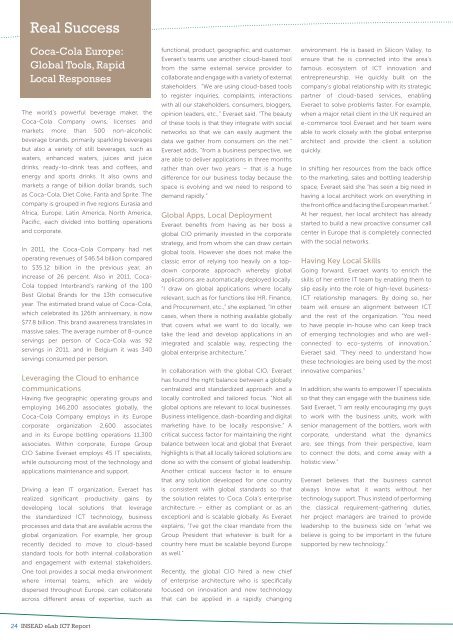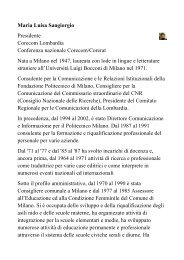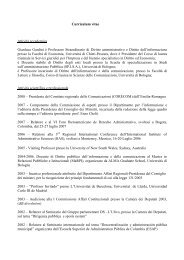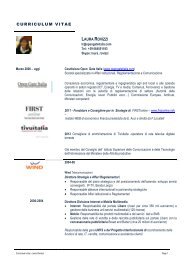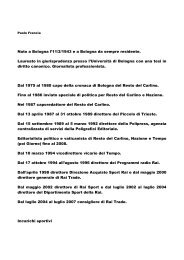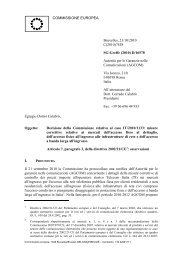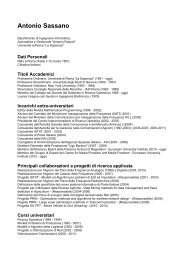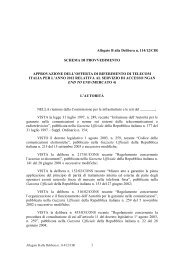Building Competitiveness and Business Performance with ICT
Building Competitiveness and Business Performance with ICT
Building Competitiveness and Business Performance with ICT
- No tags were found...
Create successful ePaper yourself
Turn your PDF publications into a flip-book with our unique Google optimized e-Paper software.
Real SuccessCoca-Cola Europe:Global Tools, RapidLocal ResponsesThe world’s powerful beverage maker, theCoca-Cola Company owns, licenses <strong>and</strong>markets more than 500 non-alcoholicbeverage br<strong>and</strong>s, primarily sparkling beveragesbut also a variety of still beverages, such aswaters, enhanced waters, juices <strong>and</strong> juicedrinks, ready-to-drink teas <strong>and</strong> coffees, <strong>and</strong>energy <strong>and</strong> sports drinks. It also owns <strong>and</strong>markets a range of billion dollar br<strong>and</strong>s, suchas Coca-Cola, Diet Coke, Fanta <strong>and</strong> Sprite. Thecompany is grouped in five regions Eurasia <strong>and</strong>Africa, Europe, Latin America, North America,Pacific, each divided into bottling operations<strong>and</strong> corporate.In 2011, the Coca-Cola Company had netoperating revenues of $46.54 billion comparedto $35.12 billion in the previous year, anincrease of 26 percent. Also in 2011, Coca-Cola topped Interbr<strong>and</strong>’s ranking of the 100Best Global Br<strong>and</strong>s for the 13th consecutiveyear. The estimated br<strong>and</strong> value of Coca‐Cola,which celebrated its 126th anniversary, is now$77.8 billion. This br<strong>and</strong> awareness translates inmassive sales. The average number of 8-ounceservings per person of Coca-Cola was 92servings in 2011, <strong>and</strong> in Belgium it was 340servings consumed per person.Leveraging the Cloud to enhancecommunicationsHaving five geographic operating groups <strong>and</strong>employing 146,200 associates globally, theCoca-Cola Company employs in its Europecorporate organization 2,600 associates<strong>and</strong> in its Europe bottling operations 11,300associates. Within corporate, Europe GroupCIO Sabine Everaet employs 45 IT specialists,while outsourcing most of the technology <strong>and</strong>applications maintenance <strong>and</strong> support.Driving a lean IT organization, Everaet hasrealized significant productivity gains bydeveloping local solutions that leveragethe st<strong>and</strong>ardized <strong>ICT</strong> technology, businessprocesses <strong>and</strong> data that are available across theglobal organization. For example, her grouprecently decided to move to cloud-basedst<strong>and</strong>ard tools for both internal collaboration<strong>and</strong> engagement <strong>with</strong> external stakeholders.One tool provides a social media environmentwhere internal teams, which are widelydispersed throughout Europe, can collaborateacross different areas of expertise, such asfunctional, product, geographic, <strong>and</strong> customer.Everaet’s teams use another cloud-based toolfrom the same external service provider tocollaborate <strong>and</strong> engage <strong>with</strong> a variety of externalstakeholders. “We are using cloud-based toolsto register inquiries, complaints, interactions<strong>with</strong> all our stakeholders, consumers, bloggers,opinion leaders, etc.,” Everaet said. “The beautyof these tools is that they integrate <strong>with</strong> socialnetworks so that we can easily augment thedata we gather from consumers on the net.”Everaet adds, “from a business perspective, weare able to deliver applications in three monthsrather than over two years – that is a hugedifference for our business today because thespace is evolving <strong>and</strong> we need to respond todem<strong>and</strong> rapidly.”Global Apps, Local DeploymentEveraet benefits from having as her boss aglobal CIO primarily invested in the corporatestrategy, <strong>and</strong> from whom she can draw certainglobal tools. However she does not make theclassic error of relying too heavily on a topdowncorporate approach whereby globalapplications are automatically deployed locally.“I draw on global applications where locallyrelevant, such as for functions like HR, Finance,<strong>and</strong> Procurement, etc.,” she explained, “In othercases, when there is nothing available globallythat covers what we want to do locally, wetake the lead <strong>and</strong> develop applications in anintegrated <strong>and</strong> scalable way, respecting theglobal enterprise architecture,”In collaboration <strong>with</strong> the global CIO, Everaethas found the right balance between a globallycentralized <strong>and</strong> st<strong>and</strong>ardized approach <strong>and</strong> alocally controlled <strong>and</strong> tailored focus. “Not allglobal options are relevant to local businesses.<strong>Business</strong> intelligence, dash-boarding <strong>and</strong> digitalmarketing have to be locally responsive.” Acritical success factor for maintaining the rightbalance between local <strong>and</strong> global that Everaethighlights is that all locally tailored solutions aredone so <strong>with</strong> the consent of global leadership.Another critical success factor is to ensurethat any solution developed for one countryis consistent <strong>with</strong> global st<strong>and</strong>ards so thatthe solution relates to Coca Cola’s enterprisearchitecture – either as compliant or as anexception) <strong>and</strong> is scalable globally. As Everaetexplains, “I’ve got the clear m<strong>and</strong>ate from theGroup President that whatever is built for acountry here must be scalable beyond Europeas well.”Recently, the global CIO hired a new chiefof enterprise architecture who is specificallyfocused on innovation <strong>and</strong> new technologythat can be applied in a rapidly changingenvironment. He is based in Silicon Valley, toensure that he is connected into the area’sfamous ecosystem of <strong>ICT</strong> innovation <strong>and</strong>entrepreneurship. He quickly built on thecompany’s global relationship <strong>with</strong> its strategicpartner of cloud-based services, enablingEveraet to solve problems faster. For example,when a major retail client in the UK required ane-commerce tool Everaet <strong>and</strong> her team wereable to work closely <strong>with</strong> the global enterprisearchitect <strong>and</strong> provide the client a solutionquickly.In shifting her resources from the back officeto the marketing, sales <strong>and</strong> bottling leadershipspace, Everaet said she “has seen a big need inhaving a local architect work on everything inthe front office <strong>and</strong> facing the European market.”At her request, her local architect has alreadystarted to build a new proactive consumer callcenter in Europe that is completely connected<strong>with</strong> the social networks.Having Key Local SkillsGoing forward, Everaet wants to enrich theskills of her entire IT team by enabling them toslip easily into the role of high-level business-<strong>ICT</strong> relationship managers. By doing so, herteam will ensure an alignment between <strong>ICT</strong><strong>and</strong> the rest of the organization. “You needto have people in-house who can keep trackof emerging technologies <strong>and</strong> who are wellconnectedto eco-systems of innovation,”Everaet said. “They need to underst<strong>and</strong> howthese technologies are being used by the mostinnovative companies.”In addition, she wants to empower IT specialistsso that they can engage <strong>with</strong> the business side.Said Everaet, “I am really encouraging my guysto work <strong>with</strong> the business units, work <strong>with</strong>senior management of the bottlers, work <strong>with</strong>corporate, underst<strong>and</strong> what the dynamicsare, see things from their perspective, learnto connect the dots, <strong>and</strong> come away <strong>with</strong> aholistic view.”Everaet believes that the business cannotalways know what it wants <strong>with</strong>out hertechnology support. Thus instead of performingthe classical requirement-gathering duties,her project managers are trained to provideleadership to the business side on “what webelieve is going to be important in the futuresupported by new technology.”24 INSEAD eLab <strong>ICT</strong> Report


